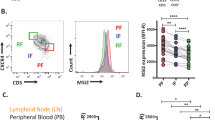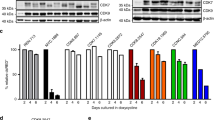Abstract
Chronic myelogenous leukemia (CML) is a myeloproliferative disorder defined by the presence of the fusion gene BCR-ABL1 in primitive hematopoietic progenitors. The myeloid leukemia factors (MLFs) were identified in the fly and human, and are involved in acute leukemia and enhancing the myeloid factor; however, the function of MLF2 in CML is poorly understood. In this study, we demonstrated that MLF2 may play an oncogenic role in CML. The expression level of MLF2 was related to the proliferation, colony-formation ability, and sensitivity to imatinib in K562 cells. Moreover, phosphorylation at serine 24, detected through Phos-tag sodium dodecyl sulfate-polyacrylamide gel electrophoresis, was required to maintain the activity of MLF2 in CML. The effects of MLF2 overexpression on the colony-formation ability in vitro and mouse survival in vivo could be alleviated by point mutation of MLF2 at serine 24. These findings uncover the oncogenic role of MLF2 through phosphorylation at serine 24 and provide a novel therapeutic target in CML.
This is a preview of subscription content, access via your institution
Access options
Subscribe to this journal
Receive 12 print issues and online access
$259.00 per year
only $21.58 per issue
Buy this article
- Purchase on Springer Link
- Instant access to full article PDF
Prices may be subject to local taxes which are calculated during checkout





Similar content being viewed by others
References
Chu S, Li L, Singh H, Bhatia R. BCR-tyrosine 177 plays an essential role in Ras and Akt activation and in human hematopoietic progenitor transformation in chronic myelogenous leukemia. Cancer Res. 2007;67:7045–53.
Sawyers CL. Chronic myeloid leukemia. New Engl J Med. 1999;340:1330–40.
Druker BJ, Talpaz M, Resta DJ, Peng B, Buchdunger E, Ford JM, et al. Efficacy and safety of a specific inhibitor of the BCR-ABL tyrosine kinase in chronic myeloid leukemia. New Engl J Med. 2001;344:1031–7.
Corbin AS, O'Hare T, Gu Z, Kraft IL, Eiring AM, Khorashad JS, et al. KIT signaling governs differential sensitivity of mature and primitive CML progenitors to tyrosine kinase inhibitors. Cancer Res. 2013;73:5775–86.
Taylor J, Xiao W, Abdel-Wahab O. Diagnosis and classification of hematologic malignancies on the basis of genetics. Blood. 2017;130:410–23.
Bras S, Martin-Lanneree S, Gobert V, Auge B, Breig O, Sanial M, et al. Myeloid leukemia factor is a conserved regulator of RUNX transcription factor activity involved in hematopoiesis. Proc Natl Acad Sci USA. 2012;109:4986–91.
Winteringham LN, Kobelke S, Williams JH, Ingley E, Klinken SP. Myeloid leukemia factor 1 inhibits erythropoietin-induced differentiation, cell cycle exit and p27Kip1 accumulation. Oncogene. 2004;23:5105–9.
Kuefer MU, Look AT, Williams DC, Valentine V, Naeve CW, Behm FG, et al. cDNA cloning, tissue distribution, and chromosomal localization of myelodysplasia/myeloid leukemia factor 2 (MLF2). Genomics. 1996;35:392–6.
Choudhury KR, Raychaudhuri S, Bhattacharyya NP. Identification of HYPK-interacting proteins reveals involvement of HYPK in regulating cell growth, cell cycle, unfolded protein response and cell death. PLoS ONE. 2012;7:e51415.
Banerjee M, Datta M, Bhattacharyya NP. Modulation of mutant Huntingtin aggregates and toxicity by human myeloid leukemia factors. Int J Biochem Cell Biol. 2017;82:1–9.
Dave B, Granados-Principal S, Zhu R, Benz S, Rabizadeh S, Soon-Shiong P, et al. Targeting RPL39 and MLF2 reduces tumor initiation and metastasis in breast cancer by inhibiting nitric oxide synthase signaling. Proc Natl Acad Sci USA. 2014;111:8838–43.
Hunter T. Protein kinases and phosphatases: the yin and yang of protein phosphorylation and signaling. Cell. 1995;80:225–36.
Pendergast AM, Quilliam LA, Cripe LD, Bassing CH, Dai Z, Li N, et al. BCR-ABL-induced oncogenesis is mediated by direct interaction with the SH2 domain of the GRB-2 adaptor protein. Cell. 1993;75:175–85.
Gerboth S, Frittoli E, Palamidessi A, Baltanas FC, Salek M, Rappsilber J, et al. Phosphorylation of SOS1 on tyrosine 1196 promotes its RAC GEF activity and contributes to BCR-ABL leukemogenesis. Leukemia. 2018;32:820–7.
Kinoshita E, Kinoshita-Kikuta E, Takiyama K, Koike T. Phosphate-binding tag, a new tool to visualize phosphorylated proteins. Mol Cell Proteomics. 2006;5:749–57.
de Bruijn M, Dzierzak E. Runx transcription factors in the development and function of the definitive hematopoietic system. Blood. 2017;129:2061–9.
Yu J, Deshmukh H, Payton JE, Dunham C, Scheithauer BW, Tihan T, et al. Array-based comparative genomic hybridization identifies CDK4 and FOXM1 alterations as independent predictors of survival in malignant peripheral nerve sheath tumor. Clin Cancer Res. 2011;17:1924–34.
Miller M, Chen A, Gobert V, Auge B, Beau M, Burlet-Schiltz O, et al. Control of RUNX-induced repression of Notch signaling by MLF and its partner DnaJ-1 during Drosophila hematopoiesis. PLoS Genet. 2017;13:e1006932.
Lala PK, Chakraborty C. Role of nitric oxide in carcinogenesis and tumour progression. Lancet Oncol. 2001;2:149–56.
Chowdhury AA, Chaudhuri J, Biswas N, Manna A, Chatterjee S, Mahato SK, et al. Synergistic apoptosis of CML cells by buthionine sulfoximine and hydroxychavicol correlates with activation of AIF and GSH-ROS-JNK-ERK-iNOS pathway. PloS ONE. 2013;8:e73672.
Gallipoli P, Cook A, Rhodes S, Hopcroft L, Wheadon H, Whetton AD, et al. JAK2/STAT5 inhibition by nilotinib with ruxolitinib contributes to the elimination of CML CD34+ cells in vitro and in vivo. Blood. 2014;124:1492–501.
Bertacchini J, Heidari N, Mediani L, Capitani S, Shahjahani M, Ahmadzadeh A, et al. Targeting PI3K/AKT/mTOR network for treatment of leukemia. Cell Mol Life Sci. 2015;72:2337–47.
Juan WC, Ong ST. The role of protein phosphorylation in therapy resistance and disease progression in chronic myelogenous leukemia. Prog Mol Biol Transl Sci. 2012;106:107–42.
Funding
This work was supported by grants from the National Natural Science Foundation of China (No. 81170496), Research Project for Practice Development of National TCM Clinical Research Bases (No. JDZX2015119), Science and Technology Program of Guangdong Province (Nos. 2014A020212729, 2016A020226027), Science and Technology Program of Guangzhou City (No. 201504281729050), and the Fundamental Research Funds for the Central Universities (No. 21617461).
Author information
Authors and Affiliations
Contributions
JF conceived and designed the experiments. JY, YZ, and GH performed the experiments. JY, YL, DC, and GH analyzed the data. OR, ZY, CG, and YL contributed reagents, materials, and analytical tools. DC, OR, and CS prepared the normal and patients sample. JF, JY, and ZY wrote the paper.
Corresponding author
Ethics declarations
Conflict of interest
The authors declare that they have no conflict of interest.
Additional information
Publisher’s note Springer Nature remains neutral with regard to jurisdictional claims in published maps and institutional affiliations.
Supplementary information
Rights and permissions
About this article
Cite this article
Yang, J., Cao, D., Zhang, Y. et al. The role of phosphorylation of MLF2 at serine 24 in BCR-ABL leukemogenesis. Cancer Gene Ther 27, 98–107 (2020). https://doi.org/10.1038/s41417-019-0152-4
Received:
Revised:
Accepted:
Published:
Issue Date:
DOI: https://doi.org/10.1038/s41417-019-0152-4



